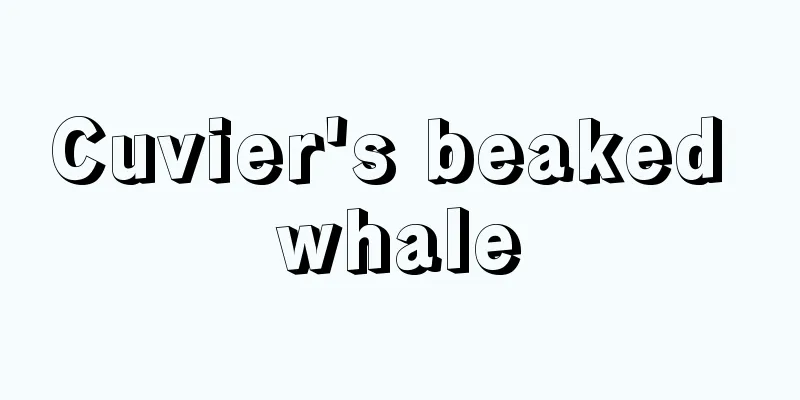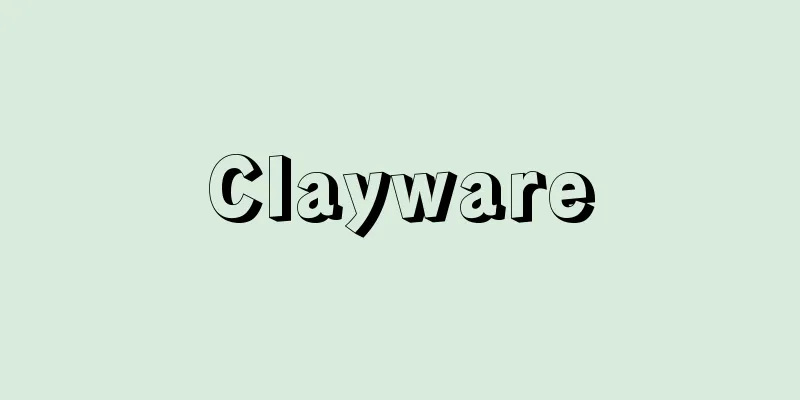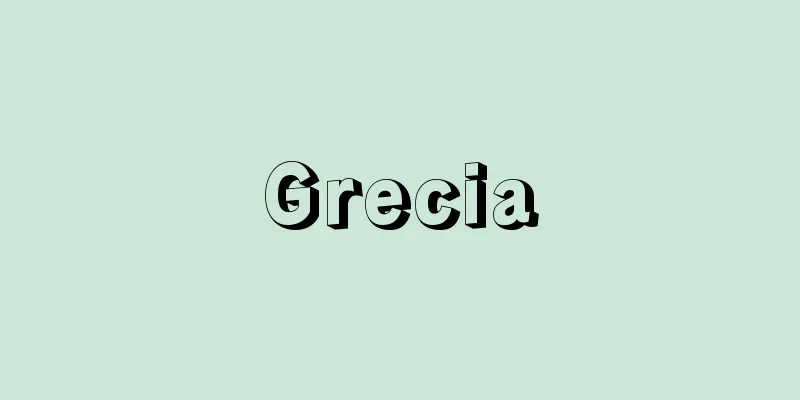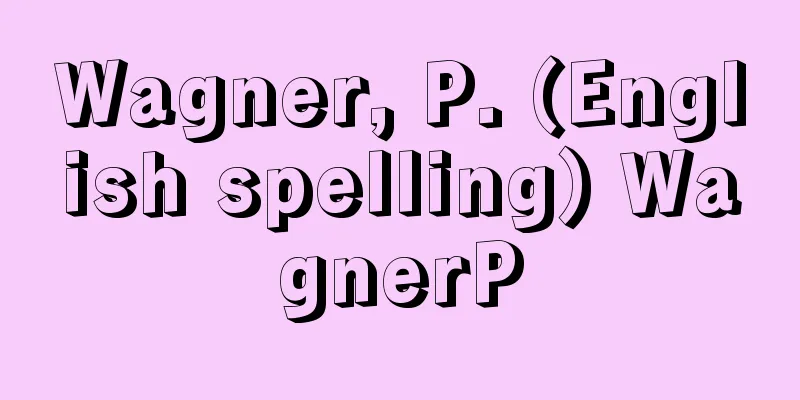Liquor tax - shuzei
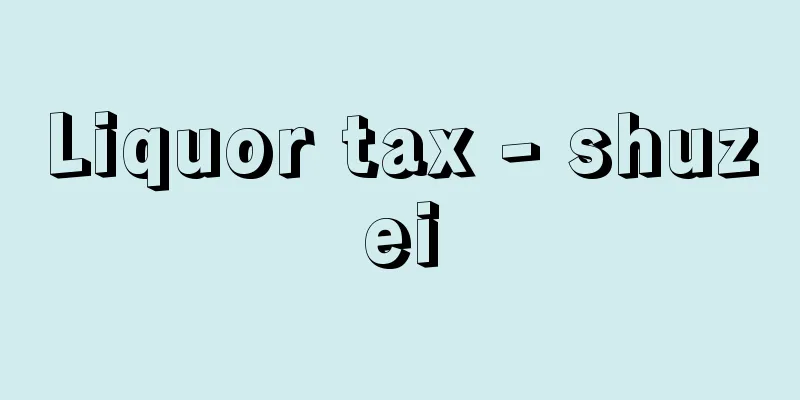
|
An indirect consumption tax on alcoholic beverages. It defines alcoholic beverages as beverages with a certain alcohol content or more (in Japan, 1% or more), and sets tax rates according to ingredients, manufacturing method, and alcohol content. It is a tax levied on alcoholic beverage manufacturers, wholesalers, and retailers. Alcoholic beverages are a universal luxury item, and consumption is stable, making it easy to secure tax revenue. Excessive drinking can disrupt social morals, so high taxes are easily accepted. For this reason, alcohol taxes have become a major tax item in tax systems around the world, alongside income taxes. In Japan, temporary taxes were imposed on sake koji sellers from the Kamakura period, and the first permanent tax was imposed on sake shops in 1371 (Oan 4) by Ashikaga Yoshimitsu. Modern liquor taxes began with the Dajokan proclamation of 1871 (Meiji 4) that established the "Regulations on the Issuance of Brewing Licenses for Sake, Cloudy Sake, and Soy Sauce and the Method of Tax Collection." The Liquor Tax Law was enacted in 1896, followed by the Alcohol and Alcohol-Containing Beverages Tax Law and the Beer Tax Law in 1918 (Taisho 7), and these were unified into the Liquor Tax Law in 1940 (Showa 15). The current Liquor Tax Law was enacted in 1953 (Showa 28). The liquor tax system has been frequently revised due to changes in alcohol consumption, securing tax revenue, harmonizing with international tax systems, and for policy purposes, such as the introduction of a beer tax to boost military forces after the Boxer Rebellion in 1900. In Japan's tax revenue, land tax accounted for the majority of national tax revenue in the early Meiji period, but the proportion of liquor tax rose thereafter, and in 1899, liquor tax exceeded land tax's 32.5% at 35.5%. The liquor tax's share of total national taxes was 19.8% in 1930 and 18.5% in 1950, remaining the major tax both before and after the war. However, it fell to 7.9% in 1970, 3.1% in 1990 (Heisei 2), and to 2.1% in 2018 (Heisei 30). Liquor tax revenue also peaked at 2.2021 trillion yen in 1988, but fell to 1.271 trillion yen in 2019 (Reiwa 1). In 1975, beer (63%) and sake (28%) accounted for 90% of the total amount of alcoholic beverages subject to taxation, but by 2018, diversification had progressed to beer at 29%, liqueurs at 28%, spirits etc. at 9%, happoshu at 7%, and sake at 6%. The liquor tax system has changed in response to internationalization. After the war, liquor taxes were, in principle, specific taxes, with ad valorem taxes applied only to some high-priced liquors (special grade sake, whiskey, etc.). However, as trade liberalization progressed, European countries in the 1980s called for improvements to Japan's liquor tax system, claiming it was a trade barrier, and the General Agreement on Tariffs and Trade (GATT) recommended that Japan revise its liquor tax system. In the 1989 revision of the Liquor Tax Law, ad valorem taxes and the classification system for sake and whiskey were abolished, and the tax rates on whiskey and other products were lowered. In 1996, the World Trade Organization (WTO) recommended that the tax disparity between shochu and whiskey be corrected, and the tax rate on whiskey was lowered and the tax rate on shochu was raised. Japan's liquor tax system (classified into 10 types) continued to be criticized as being complicated, and in 2006 the Liquor Tax Law was revised to simplify it into four categories: "sparkling alcoholic beverages" such as beer, "brewed alcoholic beverages" such as sake and wine, "distilled alcoholic beverages" such as shochu and whiskey, and "mixed alcoholic beverages" such as plum wine and chuhai. The 2017 revision introduced a liquor tax exemption system for foreign visitors to Japan at domestic sake breweries and wineries, with the aim of developing overseas markets. The current system also takes the form of a specific tax, with a basic tax rate set for each of the four categories, and liquor tax rates set for each finer type and alcohol content. The basic liquor tax rates (as of October 2020, per kiloliter) are: (1) sparkling alcoholic beverages: 200,000 yen (reduced to 155,000 yen in October 2026); (2) brewed alcoholic beverages: 120,000 yen (reduced to 100,000 yen in October 2023); (3) distilled alcoholic beverages: 200,000 yen (for alcoholic beverages with an alcohol content of 21 degrees or more, the rate will be 200,000 yen plus 10,000 yen for each degree by which the alcohol content exceeds 20 degrees); and (4) mixed alcoholic beverages: 200,000 yen (for alcoholic beverages with an alcohol content of 21 degrees or more, the rate will be 200,000 yen plus 10,000 yen for each degree by which the alcohol content exceeds 20 degrees). Alcoholic beverages with increasing consumption are judged to have a high tax-bearing capacity and are subject to tax increases, while alcoholic beverages with sluggish consumption are subject to tax reductions. After World War II, the liquor tax on sake, beer, and whiskey was repeatedly increased, but when sake consumption stagnated during the Heisei period (1989-2019), the tax on beer was increased. In response to the beer tax increase in 1994, beer companies developed "happoshu" (low-malt beer) that uses less malt than the regulation (67% or more), and when the tax on happoshu was increased in 2003, they developed "third beer" made from peas and other ingredients without using malt, and fought back against the tax increase by developing new products. As a result, a unique distortion in Japan was created in which "beer," "happoshu," and "third beer" are taxed differently despite being beer-like beverages with similar tastes. For this reason, the 2017 Liquor Tax Act amendments will gradually unify the liquor tax (350 ml) on three beer-related beverages to 54.25 yen between October 2020 and October 2026. The tax on "beer" will be reduced by 22.75 yen, while the tax on "happoshu" will increase by 7.26 yen and that on "third beer" by 26.25 yen. The liquor tax (350 ml) on low-alcohol beverages such as sake, wine, and chuhai will be unified to 35 yen. The tax on sake will be reduced by 7 yen, while that on wine and low-alcohol beverages will be increased by 7 yen, encouraging sake and beer companies to compete in the global market. With the expansion of alcohol sales at supermarkets and convenience stores, the number of alcohol retailers has increased by 30% nationwide over the past 20 years, but privately owned general liquor stores have decreased by 40% to about 41,000 (National Tax Agency data for 2016). The Liberal Democratic Party, which has small and medium-sized liquor stores as its support base, has amended the Liquor Tax Act (enforced in June 2017) through a parliamentary bill to regulate excessive discounts on alcohol, claiming that discounts at mass retailers are putting pressure on the management of "local liquor stores." It prohibits retailers that handle alcohol from selling at prices below the total selling cost (purchase price + sales and administrative costs such as labor costs) and tightens the payment standards for sales incentives (kickbacks) from beer companies, which retailers use as a source of funds for discounts. The National Tax Agency has decided that violations will be punished by making the company's name public, a fine of up to 500,000 yen, and the revocation of the liquor license. [Takeshi Yano January 21, 2021] [Reference item] | | |Source: Shogakukan Encyclopedia Nipponica About Encyclopedia Nipponica Information | Legend |
|
酒類に課される間接消費税。酒類を一定のアルコール分以上(日本では1度以上)の飲料と定義し、原料、製法、アルコール分ごとの税率を設け、酒類製造者や卸・販売業者に課す税金である。酒類は普遍的な嗜好(しこう)品で、消費量も安定的で税収を確保しやすく、過度な飲酒は社会風紀を乱すおそれがあるため高率税が容認されやすい。このため酒税は世界各国で、所得税とならぶ税制の主要税目となってきた。日本では、鎌倉時代から酒麹(さけこうじ)売業者への臨時徴税が行われ、恒常的な課税は1371年(応安4)、足利義満(よしみつ)が酒屋に課したのが最初とされる。近代的酒税は1871年(明治4)の太政官(だじょうかん)布告「清酒、濁酒、醤油(しょうゆ)醸造鑑札収与並ニ収税方法規則」制定に始まる。1896年に酒造税法が、1918年(大正7)には酒精及酒精含有飲料税法と麦酒税法ができ、1940年(昭和15)に酒税法として統一された。現行の酒税法は1953年(昭和28)の制定。酒税制度は、酒類消費の変化、税収の確保、国際税制との調和の観点や、1900年の義和団(ぎわだん)事件(北清(ほくしん)事変)後の軍備増強のためビール課税が始まったように、政策目的で頻繁に改正されている。 日本の税収は、明治初期には地租が国税収入の大部分を占めたが、その後、酒税比率が上昇し、1899年には酒税が35.5%と地租32.5%を上回った。国税全体に占める酒税比率は1930年19.8%、1950年18.5%と戦前戦後を通じて主要税の座にあった。しかし1970年7.9%、1990年(平成2)3.1%と下がり、2018年(平成30)に2.1%まで低下。酒税収入もピークの1988年に2兆2021億円あったが、2019年(令和1)には1兆2710億円まで減った。1975年の課税対象となる酒類数量はビール(63%)と清酒(28%)で全体の9割を占めていたが、2018年にはビール29%、リキュール28%、スピリッツ等9%、発泡酒7%、清酒6%と多様化が進んだ。 国際化に対応して酒税制度は変わってきた。戦後、酒税は原則として従量税で、一部の高価格酒(清酒特級、ウイスキー類など)のみに従価税を適用していた。しかし貿易自由化が進み、1980年代にヨーロッパ諸国が日本の酒税制度は貿易障壁であると改善を求め、ガット(GATT、関税および貿易に関する一般協定)が日本に酒税制度を是正するよう勧告。1989年酒税法改正で、従価税と清酒・ウイスキーの級別制度を廃止し、ウイスキーなどの税率を下げた。1996年には世界貿易機関(WTO)から焼酎(しょうちゅう)とウイスキーの酒税格差是正を勧告され、ウイスキーの税率を下げ、焼酎の税率を上げた。その後も、日本の酒税制度(10種類に分類)が複雑との批判を受け、2006年酒税法改正で、ビールなどの「発泡性酒類」、日本酒やワインなどの「醸造酒類」、焼酎やウイスキーなどの「蒸留酒類」、梅酒やチューハイなどの「混成酒類」の4分類に簡素化した。2017年改正では、海外市場を開拓する目的で、訪日外国人に対し国内酒蔵やワイナリーでの酒税免税制度を導入した。現行制度も従量税の形式をとっており、4分類ごとに基本税率を定め、さらに細かな種類やアルコール分ごとに酒税率をきめている。酒税の基本税率(2020年10月時点、1キロリットル当り)は、(1)発泡性酒類20万円(2026年10月に15万5000円まで引下げ)、(2)醸造酒類12万円(2023年10月に10万円に引下げ)、(3)蒸留酒類20万円(アルコール分21度以上は、アルコール分が20度を超える1度ごとに20万円に1万円を加えた金額とする)、(4)混成酒類20万円(アルコール分21度以上はアルコール分が20度を超える1度ごとに、20万円に1万円を加えた金額とする)。 消費量が増える酒類は担税能力が高いと判断して増税し、消費が低迷する酒類は減税する傾向にある。第二次世界大戦後、清酒、ビール、ウイスキーの酒税は増税を繰り返したが、清酒消費が低迷した平成期(1989~2019年)に入ると、ビールを増税した。1994年のビール増税に対し、ビール会社は麦芽使用量を規定(67%以上)より抑えるなどした「発泡酒」を開発し、2003年の発泡酒増税時には、麦芽を使わずにエンドウ豆などでつくった「第3のビール」を開発し、新商品開発で増税に対抗してきた。この結果、似た味のビール系飲料であるのに「ビール」「発泡酒」「第3のビール」の税額が異なるという日本独特のゆがみが生じた。このため2017年酒税法改正で、2020年10月から2026年10月にかけて段階的に三つのビール系飲料の酒税(350ミリリットル)は54.25円に統一。「ビール」を22.75円減税する一方、「発泡酒」は7.26円、「第3のビール」は26.25円、それぞれ増税とする。日本酒類、ワイン類、チューハイなどの低アルコール飲料の酒税(350ミリリットル)は35円に統一する。日本酒類は7円の減税となる一方、ワイン類や低アルコール飲料は7円増税とし、酒造会社やビール会社に世界市場での競争を促す。 なおスーパーマーケットやコンビニエンス・ストアでの酒類販売の拡大で、過去20年間で酒類の小売店は全国で3割増えたが、個人経営などの一般酒販店は約4万1000店と4割に減った(2016年度国税庁資料)。中小酒販店を支持基盤とする自民党などは、量販店の酒類安売りが「街の酒屋さん」の経営を圧迫しているとして、議員立法で酒税法を改正(2017年6月施行)し、酒類の過度な安売りを規制した。酒類を扱う小売店に、総販売原価(仕入れ値+人件費などの販売管理費)を下回る価格での販売を禁止し、小売店が値下げの原資としているビール会社からの販売奨励金(リベート)の支払い基準を厳しくした。国税庁は違反した場合、社名公表、50万円以下の罰金、酒販免許取消しなどの処分を科すとした。 [矢野 武 2021年1月21日] [参照項目] | | |出典 小学館 日本大百科全書(ニッポニカ)日本大百科全書(ニッポニカ)について 情報 | 凡例 |
Recommend
Elro Furnace - Elro
Indirect arc furnaces are generally used in place...
Eurylaimidae
…any of the birds of the family Eurylaimidae, whi...
Imperial Headquarters - Daihonei
The Imperial General Headquarters was established...
Dnipro
The Dnipro River is a large river that flows sout...
"Compromise between Classical and Proverbs"
…Following the heyday of the Old School, in the s...
Sulfonamide
...Amides are widely used as raw materials in org...
Land Warfare
〘 noun 〙 Land battle. ※ Seiyo Kibun (around 1725) ...
Austenite (English spelling)
This refers to the allotrope gamma iron, which is ...
Mount Kurikoma
A double stratovolcano (→composite volcano) that s...
Kunshan
[1] A prefecture in Jiangsu Province, China. Locat...
Iroha Karuta
A type of song karuta aimed at children. It consi...
Triple jump
...The pole vault and hammer throw are men's ...
Encina, J. del (English spelling) EncinaJdel
…The period of the Catholic Monarchs (Isabella I ...
Enkoji Temple
A temple of the Nanzenji school of the Rinzai sect...
Monou [town] - Monou
A former town in Monou District, eastern Miyagi Pr...


